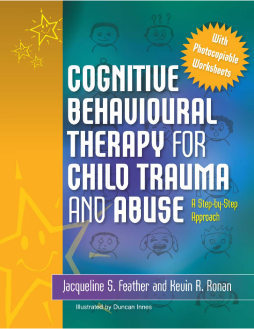
BOOK
Cognitive Behavioural Therapy for Child Trauma and Abuse
Kevin Ronan | Jacqueline S. Feather
(2010)
Additional Information
Book Details
Abstract
The effects of trauma and abuse on children can be long-lasting, acute and damaging. Evidence suggests that cognitive behavioural therapy (CBT) is a highly effective form of psychotherapy to help children to overcome these effects.
This book uses an evidence-based CBT treatment model to assist children and adolescents aged 9–15 years to resolve trauma symptoms and increase their coping skills. The approach is made up of 16 step-by-step sessions to carry out with the young person, and includes worksheets and fun activities using arts and crafts. The model uses four phases: strengthening the child's psychosocial context; enhancing their coping skills; processing their trauma through gradual exposure; and addressing special issues that the child may have and preventing relapse. The child keeps a scrapbook for the duration of the programme in which they keep worksheets, artwork and any other activities they carry out. The approach is designed for individual therapy but also includes sessions for parents and caregivers.
With photocopiable worksheets and easy to follow sessions, this will be an invaluable resource for all practitioners working with traumatised and abused children, including therapists, psychologists, counsellors, health professionals and social workers.
Jacqueline S. Feather is Senior Lecturer in Psychology at AUT University, Auckland, New Zealand. She is a clinical psychologist with over 20 years' clinical experience working with children, adolescents and their families, and has particular expertise in trauma-focused cognitive behavioral therapy interventions. Kevin R. Ronan is Professor of Psychology at CQ University, Australia. He is a clinical psychologist with nearly 25 years of clinical experience, in particular with children, adolescents and their families.
It is nice to see (the therapeutic) relationship being emphasised within such complex difficulties, this is all too often overlooked in CBT... The cultural narrative nicely mirros the collaborative and safe therapeutic environment of CBT... Many of the proposed activities such as 'paper people' are well thought out, creative, and reduce the pressure on the therapist to try to come up with activities... the authors cleverly model a scaffolded, pace and stepped approach for the therapist as much as for the client. A major strength of this programme is its development; drawing on findings in trauma literature, clinical presentation and evidence-base practice... From both a scientific and a practitioner perspective, this CBT programme does just what we expect and offers a concise, child-friendly, reflective, evidence-based therapy for child trauma.
Journal of Mental Health, Jade Smith, Clinical Psychology Trainee, University of Hull
This is a useful and practical guide to utilising CBT techniques with children who have experienced abuse... The manual itself provides session-by-session guides including a list of tools and equipment required and relevant worksheets... The approach provides good practical techniques to enhance psychological coping, and as long as this context is held in mind then this is a useful tool for practitioners working with abused and traumatised children.
Child Abuse Review
Finally a CBT resource book for practitioners who work in the specialist area of childhood trauma, which combines an easy to follow, session by session guide with practical and child-friendly resources. As an indigenous Mâori psychologist I am delighted to find a resource which highlights the importance of the cultural and familial context when working with children who have survived traumatic experiences.
Tania Cargo, Ngâti Maru, Ngâti Manu, Ngâpuhi, Clinical Psychologist, Aotearoa/New Zealand
[This] is one of those rare manuals that you pick up and, flicking through the abundance of worksheets and resources, find yourself saying, ''I can use that, and that, and that...''. This clinician-relevant appeal permeates the entire manual, with a good proportion of the book being made up of such resources... The fact that the authors state that one of the aims of this phase is to ''instill hope'' is testament to the fact that this is a manual written by clinicians who know the challenges experienced by this client group... I believe this manual will be of interest to all those who work with traumatised children and adolescents and I feel that the client group will respond to its optimistic tone and creative approaches. The book will, however, be most valued by those clinicians who have a suitable level of training in CBT and experience of working within this client group and who can therefore use this very welcome tool to its full potential.
BACP Counselling and Psychotherapy- Counselling Children and Young People, Dr Alastair Black, consultant psychotherapist and head of psychological therapies at the Police Rehabilitation and Retraining Trust (PRRT) in Northern Ireland
This book combines state-of-the-art understanding of contemporary research on post-traumatic stress disorder (PTSD) with an admirably practical and accessible approach to treatment for the clinician. Highly recommended.
Professor James Bennett-Levy, University Department of Rural Health (Northern Rivers), University of Sydney and Southern Cross University, New South Wales, Australia
An excellent guide for therapists working with traumatized abused children. To enhance recovery, this phased therapeutic approach focuses on the individual child within his/her psychosocial and cultural context.
Amanda Shea Hart, PhD, Child and Family Specialist, Adelaide, South Australia
This book is a practical resource for practitioners working with abused and traumatized youth. Using a trauma-focused cognitive-behavioural model, it covers key issues including rapport building, assessment, coping skills, gradual exposure, and termination. A welcome addition to the trauma-treatment literature.
Liana Lowenstein, MSW, author of Creative Interventions for Troubled Children and Youth
